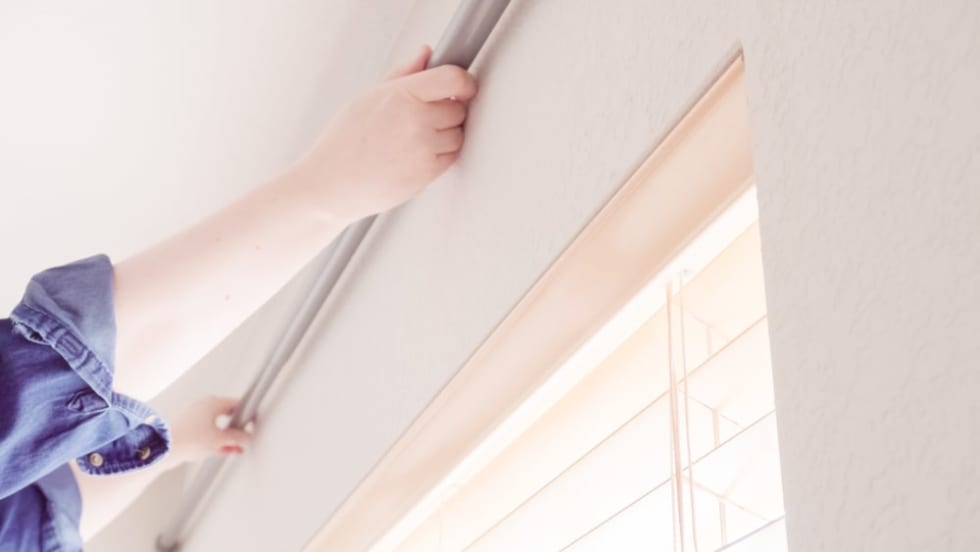South Bank at Quarry Trails
- 93 units available
- Studio • 1 bed • 2 bed • 3 bed
- Amenities
In unit laundry, Patio / balcony, Granite counters, Pet friendly, Stainless steel, Walk in closets + more

Welcome a guide for everyone who dreads the thought of wrestling with curtain rods, measuring tapes, and fussing with drills. Here, we're going to show you a variety of methods to hang curtains that are not only simple but may even be surprisingly enjoyable. Whether you're a first-time curtain hanger or a seasoned veteran looking for a less frustrating approach, our goal is to transform this often-dreaded task into a painless way to instantly upgrade your home.
On the surface, it seems like a straightforward task: just put up a rod and hang the fabric. Yet, when you get down to it, a myriad of challenges present themselves, turning what should be a simple chore into a frustrating puzzle. Drilling holes for curtain rods demands a steady hand and confidence with power tools, which not everyone possesses. Furthermore, holding up heavy curtain rods, especially when working with larger windows, can be taxing. The need to balance on a ladder or a chair while trying to maintain precision can be daunting and even unsafe at times.
Unlike other home decor tasks, hanging curtains can require a great deal of accuracy. Measurements need to be exact, not only to ensure that the curtains fit, but also to make sure they hang at the right height and width to complement your window and room. A small miscalculation in the height or width can lead to curtains that drag on the floor or don’t close properly, disrupting the entire look and function of the room.
So while hanging curtains is certainly a task almost anyone can accomplish, it’s also a task that everyone likes to put off. Here are a few ways to make hanging curtains easier so you can feel good about getting started on your project today!

Above: A standard curtain rod, which requires precise measurements and drilling
The key to a painless experience lies in selecting tools and methods that minimize the need for precision, reduce physical strain, and simplify the overall process. From innovative hardware that bypasses traditional challenges to clever tricks that guide your installation, there are several tools at your disposal to make curtain hanging a breeze.
For those who dread the thought of drilling into walls, no-drill curtain rods are a game changer. These rods typically use a tension mechanism or adhesive hooks to stay in place, eliminating the need for power tools and wall damage. Ideal for renters or anyone hesitant to make permanent changes to their walls, these rods can be easily installed and adjusted with minimal effort. Not only do they save you from the hassle of drilling, but they also offer a high degree of flexibility, allowing you to reposition or remove them as needed without leaving any trace.

Above: A tension rod, a popular form of drilless curtain hanging
Fast-fit brackets are another innovative solution designed to simplify the curtain hanging process. These brackets often snap onto the window frame, requiring no drills or screws. This approach is not only quicker but also spares your walls from holes. It’s an ideal solution for those who want a more secure option than tension rods but still wish to avoid the complexities of traditional curtain rod installation. Fast-fit brackets are particularly useful for standard window sizes, ensuring a snug and stable fit with minimal effort.
Here's a couple examples of popular fast-fit brackets if you want to see them for yourself:
Sometimes, the traditional way just needs a little tweak to become painless. Using paper or cardboard templates is a clever hack for those who prefer standard curtain rods but dread the measuring and leveling process. Simply create a template of the bracket or rod ends, mark the drill holes, and tape it to the wall. This method allows you to visualize and adjust the placement before making any holes, ensuring a level and accurately spaced installation. It’s a low-tech, low-cost solution that greatly reduces the margin for error, making the task more approachable and less stressful.
Here's a great video from theBarefoot that shows how to make a template for drilling, and how to mark it so that it also notes the perfect size for the holes as well:
Measuring for curtains is a crucial step to ensure they fit perfectly, but if you don’t like measuring, you can bypass much of the traditional process with option #3 (paper & cardboard templates). For other methods, here’s a step-by-step guide on how to measure for curtains:
Remember, while measuring can seem like a meticulous task, it ensures that your curtains will fit just as you envisioned.

Whether you're avoiding drills, seeking quick solutions, or looking for precision without the hassle of measuring, these three painless ways offer a solution for everyone.
No-drill curtains are perfect for those who prefer not to use power tools or for renters who can't make permanent changes to their walls. However, they do require you have a suitable space for a tension rod or light enough curtains for adhesive hooks.

Fast-bracket curtains offer a sturdy solution without the need for drilling. Secure the Brackets: Snap the fast-fit brackets onto the top corners of the window frame. Ensure they are level and securely in place.
For those who prefer traditional curtain rods but want to simplify the drilling process, using a template is an efficient solution.
Here is some semi-professional & semi-personal advice from the two of us based on our own experiences hanging curtains before (especially in apartments where security deposits were a concern):

If you're not just looking to change up your living space but to actively move to a new location, let Apartment List help! Take our easy quiz to get matched with an apartment in your ideal location, budget, and with great amenities!
For a classic and elegant look, hang your curtain rod 4-6 inches above the top of your window frame. This allows for ample fabric to drape and creates the illusion of higher ceilings. However, for a more relaxed and casual vibe, you can hang the rod closer to the window frame, leaving just a couple of inches above.
For optimal coverage and light control, your curtain rod should extend 4-6 inches beyond the window frame on each side. This ensures that the curtains can be drawn back fully, allowing natural light to flood the room.
If you measured everything correctly, but you still don’t like the way your curtains are hanging, try these tips:


In unit laundry, Patio / balcony, Granite counters, Pet friendly, Stainless steel, Walk in closets + more
In unit laundry, Granite counters, Hardwood floors, Dishwasher, Pet friendly, 24hr maintenance + more